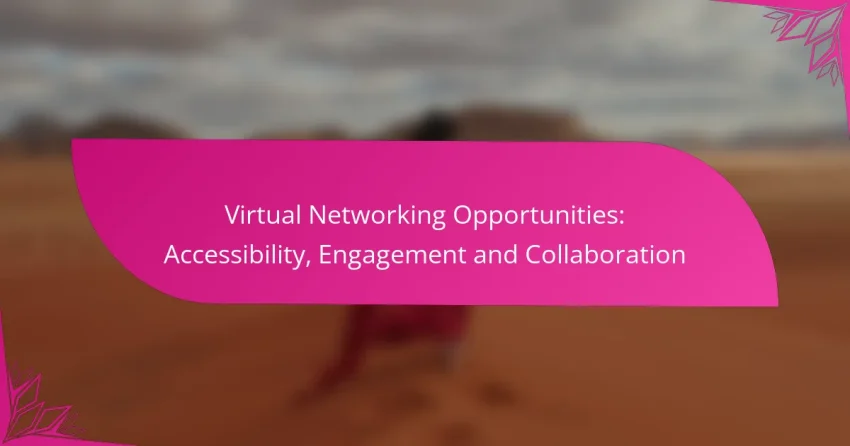Virtual networking presents a transformative opportunity for accessibility, allowing individuals from various backgrounds to connect without geographical constraints. By leveraging interactive tools and real-time communication features, these platforms enhance engagement and collaboration, fostering a sense of community among participants. This inclusive approach not only accommodates diverse needs but also enriches professional and social interactions in a dynamic online environment.

How can virtual networking enhance accessibility in the UK?
Virtual networking enhances accessibility in the UK by removing geographical barriers and providing flexible options for participation. This allows individuals from diverse backgrounds, including those with disabilities or time constraints, to engage more easily in professional and social networks.
Increased participation through online platforms
Online platforms significantly boost participation by allowing people to connect from anywhere with an internet connection. This flexibility means that individuals who may have previously faced challenges attending in-person events can now join discussions, workshops, and networking sessions without the need for travel.
Moreover, virtual events often accommodate larger audiences, enabling organizations to reach a wider demographic. This inclusivity fosters a richer exchange of ideas and experiences, benefiting all participants.
Tools like Zoom and Microsoft Teams
Tools such as Zoom and Microsoft Teams are pivotal in facilitating virtual networking. They offer features like breakout rooms, screen sharing, and chat functions, which enhance interaction and collaboration among participants. These functionalities help create a more engaging environment compared to traditional methods.
When using these tools, it’s essential to ensure that all participants are familiar with the platform’s features. Providing a brief tutorial or resources can help mitigate technical difficulties and ensure everyone can contribute effectively.

What are effective engagement strategies for virtual networking?
Effective engagement strategies for virtual networking include interactive elements that foster participation and connection among attendees. Utilizing tools like webinars and breakout rooms can significantly enhance the networking experience by encouraging dialogue and collaboration.
Interactive webinars and Q&A sessions
Interactive webinars and Q&A sessions allow participants to engage directly with speakers and each other, creating a dynamic environment. These formats encourage questions and discussions, making the experience more engaging than a traditional lecture.
To maximize engagement, consider using polls or live chat features during the session. This can help gauge audience interest and tailor content to their needs. Aim for a balance of presentation and interaction, dedicating at least 20-30% of the time for audience questions.
Utilizing breakout rooms for small group discussions
Breakout rooms facilitate small group discussions, allowing attendees to connect on a more personal level. This setup encourages deeper conversations and networking opportunities that may not occur in larger settings.
When organizing breakout sessions, keep groups small—ideally 4-6 participants—to ensure everyone has a chance to contribute. Provide clear prompts or topics for discussion to guide conversations. After the breakout, reconvene to share insights and foster a sense of community among all participants.
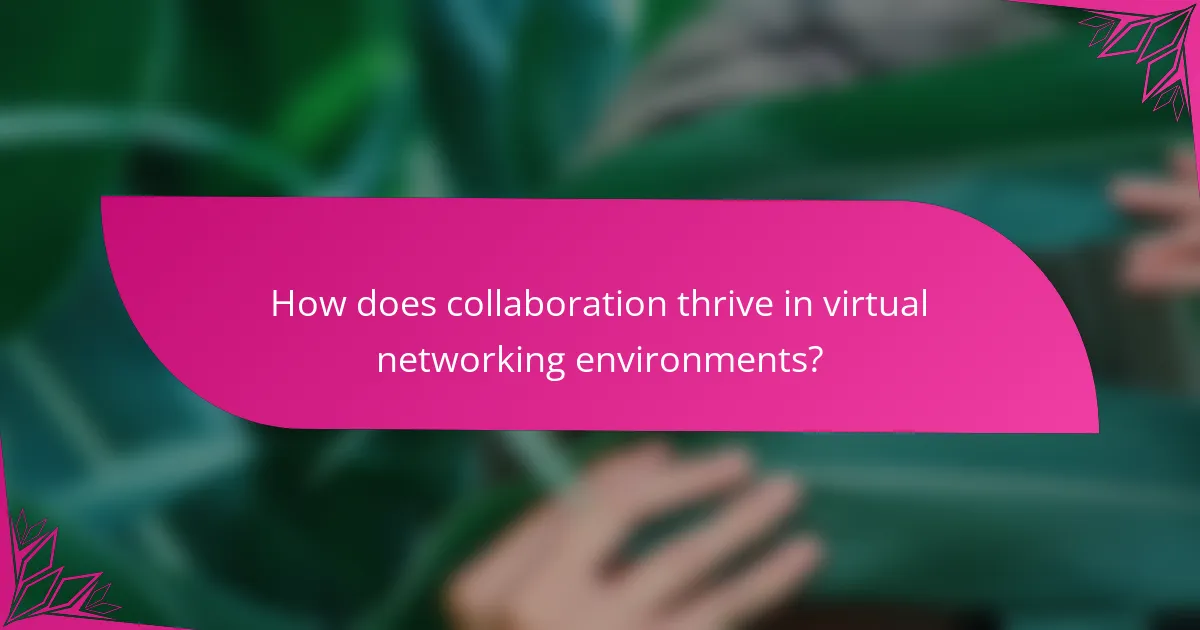
How does collaboration thrive in virtual networking environments?
Collaboration flourishes in virtual networking environments through the use of shared tools and real-time communication features that enhance teamwork and engagement. These platforms enable participants to interact seamlessly, regardless of their physical location, fostering a sense of community and shared purpose.
Shared digital workspaces like Miro and Google Workspace
Shared digital workspaces, such as Miro and Google Workspace, provide collaborative platforms where teams can brainstorm, plan, and execute projects together. These tools allow users to create and edit content simultaneously, making it easier to visualize ideas and track progress in real-time.
For example, Miro offers interactive boards that facilitate creative brainstorming sessions, while Google Workspace includes applications like Docs and Sheets that support document creation and data management. Choosing the right tool often depends on your team’s specific needs, such as the complexity of projects or the level of interactivity required.
Real-time document collaboration features
Real-time document collaboration features are essential for effective teamwork in virtual environments. These functionalities allow multiple users to edit documents simultaneously, see changes as they happen, and leave comments or suggestions instantly. This immediate feedback loop can significantly enhance productivity and decision-making.
When using tools like Google Docs, users can track changes and revert to previous versions if necessary, ensuring that no valuable input is lost. To maximize the benefits, teams should establish clear guidelines for document management and communication to avoid confusion and maintain coherence throughout the collaboration process.
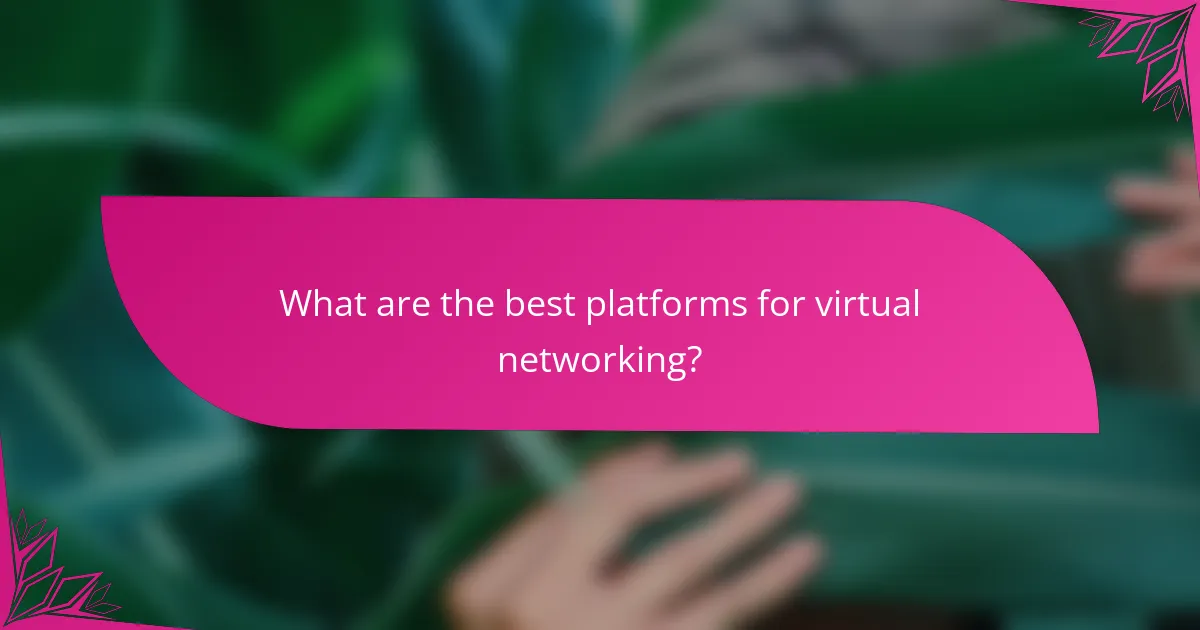
What are the best platforms for virtual networking?
The best platforms for virtual networking include LinkedIn Events and Meetup, each catering to different networking needs. LinkedIn Events focuses on professional connections, while Meetup emphasizes interest-based gatherings, making both valuable for various networking goals.
LinkedIn Events for professional connections
LinkedIn Events allows users to create and join events tailored to their professional interests. This platform is ideal for networking with industry peers, attending webinars, and participating in discussions that can enhance career opportunities.
To maximize your experience, ensure your LinkedIn profile is complete and engaging. Actively participate in discussions and follow up with connections made during events to foster relationships.
Meetup for interest-based networking
Meetup is designed for individuals to connect over shared interests, hobbies, or professional goals. Users can join groups or create events that cater to specific topics, making it easier to find like-minded individuals.
When using Meetup, consider the location and size of the group. Smaller, local meetups often provide more intimate networking opportunities, while larger events can offer broader exposure. Engage actively and follow up with new contacts to build lasting connections.
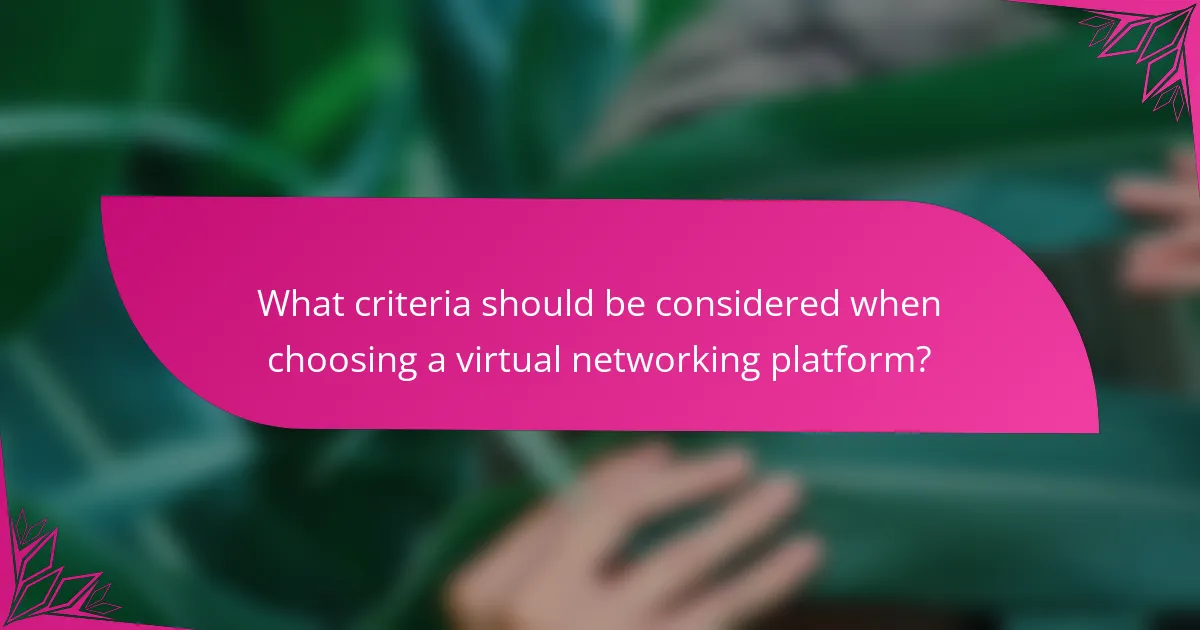
What criteria should be considered when choosing a virtual networking platform?
When selecting a virtual networking platform, consider user interface, accessibility features, and integration capabilities. These factors significantly impact user experience and overall engagement in networking events.
User interface and accessibility features
The user interface should be intuitive and easy to navigate, allowing participants to focus on networking rather than struggling with technology. Look for platforms that offer customizable layouts and clear navigation menus.
Accessibility features are crucial for inclusivity. Ensure the platform supports screen readers, offers captioning for live events, and complies with accessibility standards like WCAG. This ensures that all users, regardless of ability, can participate fully.
Integration with other tools and services
Choose a virtual networking platform that seamlessly integrates with tools you already use, such as calendar applications, email services, and project management software. This can streamline event planning and enhance collaboration.
Consider platforms that offer APIs or built-in integrations with popular services like Zoom, Slack, or Microsoft Teams. This connectivity can enhance user engagement by allowing for real-time communication and easy access to shared resources.

How can organizations measure the success of virtual networking?
Organizations can measure the success of virtual networking by analyzing participant engagement, collecting feedback, and tracking follow-up interactions. These metrics provide insights into how effectively the networking event met its goals and how participants perceived their experience.
Participant engagement metrics
To gauge participant engagement, organizations should track metrics such as attendance rates, session participation, and interaction levels during the event. For instance, monitoring the number of questions asked or comments made in chat can indicate how actively participants are involved.
Additionally, tools like polls and quizzes can provide real-time data on engagement. A good benchmark is to aim for at least 50% of attendees interacting in some form during the event, which suggests a healthy level of involvement.
Feedback surveys and follow-up interactions
Post-event feedback surveys are essential for understanding participant satisfaction and areas for improvement. Organizations should design surveys that include both quantitative ratings and qualitative comments to capture a comprehensive view of the experience.
Following up with participants through personalized emails or additional resources can enhance engagement and provide further insights into the event’s impact. Aim to send follow-up communications within a week of the event to maintain momentum and gather timely feedback.
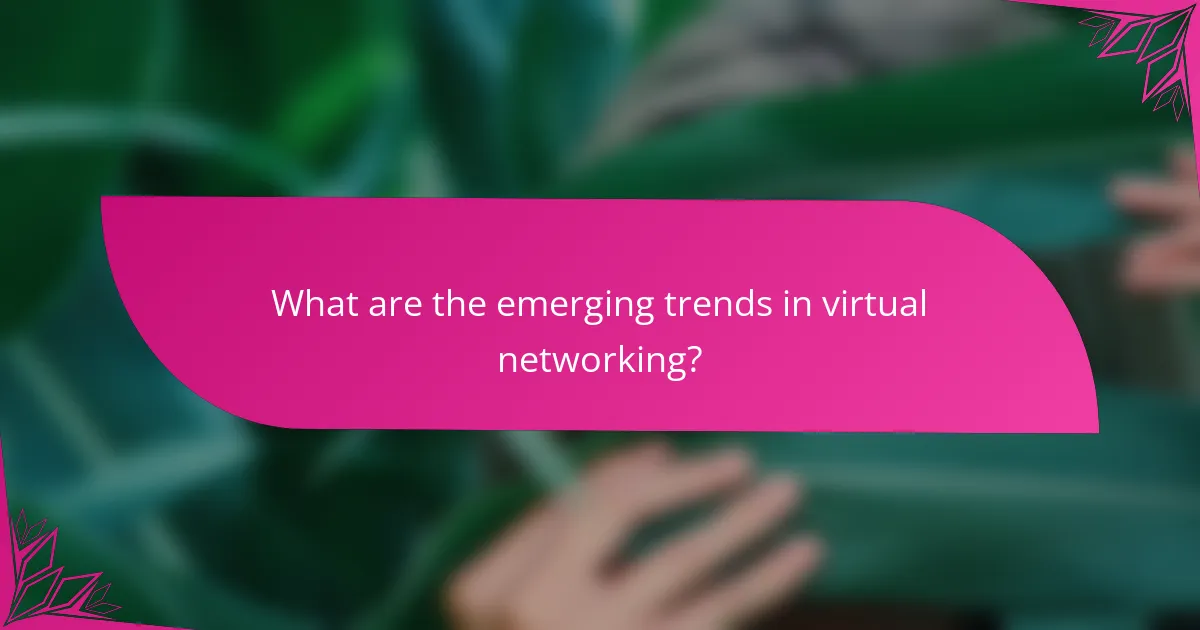
What are the emerging trends in virtual networking?
Emerging trends in virtual networking include the integration of advanced technologies, increased accessibility, and enhanced engagement strategies. These trends are reshaping how professionals connect, collaborate, and build relationships in a digital environment.
Increased use of AI for personalized experiences
The use of artificial intelligence (AI) in virtual networking is revolutionizing how individuals connect by providing tailored experiences. AI algorithms can analyze user behavior and preferences to suggest relevant contacts, events, and content, making networking more efficient and engaging.
For example, platforms may utilize AI to recommend networking sessions based on a user’s industry, interests, and past interactions. This personalization helps users maximize their time and efforts, ensuring they connect with the most relevant individuals.
When leveraging AI for networking, consider the balance between automation and personal touch. While AI can enhance efficiency, maintaining genuine human interaction is crucial for building lasting relationships. Avoid over-reliance on technology; ensure that personal engagement remains a priority in your networking strategy.
